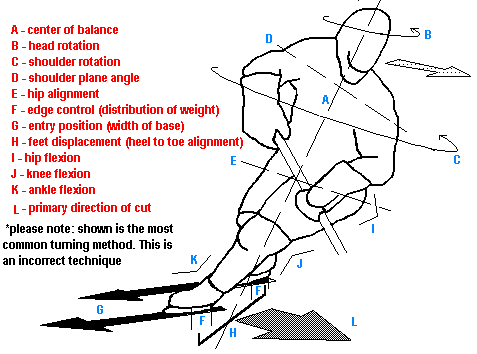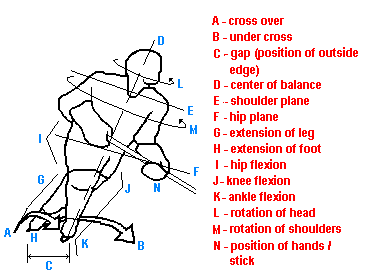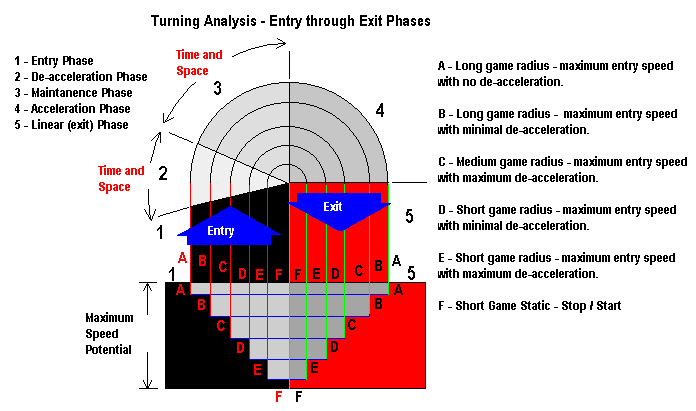

Turning, whether a gliding or "tight turn" is the term that describes the action of skating, left or right, on an arc. This arc can best be described relative to a circle or more specifically, a radius or distance from a center. If we were to look at how a player skates during game play, we would quickly see that these patterns are variations of circles and straight lines. A player's ability to maneuver around the ice at maximum speed and efficiency depends on how well he/she can execute the skill sets (basic elements of a skill) required. In order to simplify this, we can identify 5 basic elements of a turn. A player may have problems with one or more of these elements. One of the most neglected fundamentals of a turn is the de-acceleration phase. Most players enter a turn to fast, transfer their weight to the backs of their heels which creates a breaking or slowing action. Once a player feels they have slowed enough to negotiate the turn, they bring their feet back under their body to maintain or hold what speed they have left and then begin to accelerate out as their body position adjusts to allow them to do so. Break down in turning happens for many different reasons, some of the elements of which are shown below in the Maintenance Phase and Exit Phase diagrams.
MAINTENANCE PHASE

EXIT PHASE

It is easy to see where, with all of the micro-elements involved, a player could easily find themselves performing at sub-par levels. Shown are approximately 25 different elements that could go wrong, not including the Entry and De-acceleration Phases.
One of the biggest problems that face players today is neglect. As we can see in the following diagram, the smaller the radius the less time that a player has in each phase. The smaller the radius the more "exact technically" the skill must be. With all of the flow drills, breakouts and transition drills which require players to perform larger radius movements, the higher skill functions become the least practiced elements.

The five basic elements are:
1 - Entry 2- De-acceleration 3 - Maintenance 4 - Exit / Acceleration 5 - Linear transition
The lines radiating out from the middle are to there to create a relative demonstration of how time and space is reduces the tighter the circle. This forces the player to have more exacting techniques. The tighter the circle radius the more exaggerated the mistake in technique. I cannot stress enough the importance of proper skill correction and practice
For those of you who have ever taken or watched figure skating lessons, you have seen skaters going around enough circles to last you a life time. Working on balance and edge control, they practice negotiating circles of various radiuses forwards, backwards as well as when pivoting. While they of course do not have to worry about performing these turns at very high speeds with someone chasing them trying to take their head off, they are none-the-less exceptional in these fundamentals. Now, put a stick in their hands and you may get a different result but you get the point Discipline, comprehension and determination is what separates the elite "turning" player from the norm.
At this point, I am not going to go into to much depth technically since there is only so much space on this site and I am fast approaching that limit. This page will be devoted to off ice training techniques, on ice fundamentals as well as any other aid that a player could possibly use to improve their turns.
RON
Copyright © 1996 by Ron Johnson. All rights reserved.